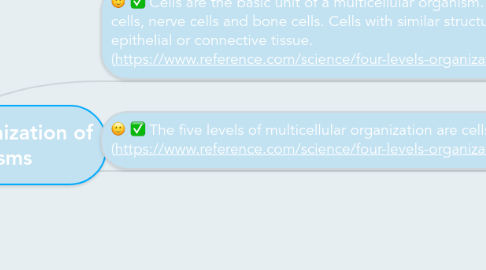
1. Cells are the basic unit of a multicellular organism. Humans have many types of cells, including blood cells, nerve cells and bone cells. Cells with similar structure and function merge to form tissues such as epithelial or connective tissue. (https://www.reference.com/science/four-levels-organization-multicellular-organism-56bba6b3ef8e3a79)
2. The five levels of multicellular organization are cells, tissues, organs, and organ systems, and organisms. (https://www.reference.com/science/four-levels-organization-multicellular-organism-56bba6b3ef8e3a79)
2.1. Tissues are any of the distinct types of material of which animals or plants are made, consisting of specialized cells and their products. (https://docs.google.com/document/d/14pgDeK5xr5oh930ZxJmvTrUCAu-Hs5G85bYuV9Tlc6w/edit)
2.1.1. Organs, such as the heart or kidney, are composed of different types of tissue to perform a specific function. Organs come together to constitute organ systems such as the nervous system, digestive system and immune system. Together, these organ systems make up an organism. ( https://www.reference.com/science/four-levels-organization-multicellular-organism-56bba6b3ef8e3a79)
2.1.1.1. Organ Systems are a group of organs that work together to perform one or more functions. Each does a particular job in the body, and is made up of certain tissues.(https://docs.google.com/document/d/14pgDeK5xr5oh930ZxJmvTrUCAu-Hs5G85bYuV9Tlc6w/edit)
2.1.2. Organisms are an individual animal, plant, or single-celled life form. (https://docs.google.com/document/d/14pgDeK5xr5oh930ZxJmvTrUCAu-Hs5G85bYuV9Tlc6w/edit)
